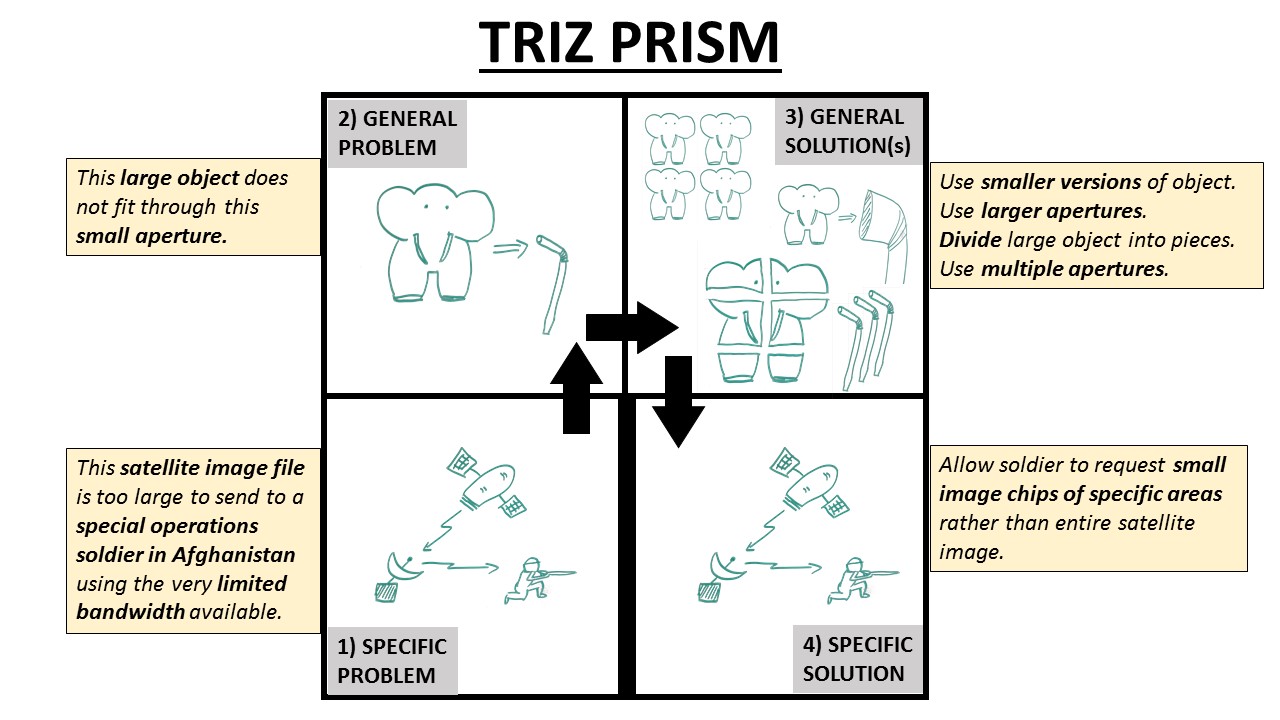The TRIZ Prism tool is a powerful way to unlock a team’s creativity and discover new solutions to difficult problems. It’s a pretty straightforward practice to describe, but actually doing it can be a little trickier than it looks at first.
The Elephant-And-Straw example in the image below is based on a real-world project Dan worked on. The activity begins in the lower left corner (the box labeled 1 – Specific Problem), we wrote a very specific problem description… and realized it was a really hard problem, with no clear solution.
That’s where the TRIZ Prism comes in. We then stripped out all the particulars and developed a general problem statement. We came up with “the big thing does not fit through the small aperture,” then explored general solutions to that category of problem. Once we came up with some general “types-of-solutions-to-that-type-of-problem,” we reintroduced some specifics and came up with a specific solution. That may sound like an obvious way to generalize & summarize the problem, but getting there took significant effort.

How did we do it? In a word – incrementally. The process of moving from Box 1 to Box 2 went something like this:
- How can we get this satellite image through this bandwidth to this soldier on this timeline?
- How can we get anything through this bandwidth to this soldier on this timeline?
- How can we get anything through any medium to this soldier on this timeline?
- How can we get anything through any medium to anyone on this timeline?
- How can we bet anything through any medium to anyone on any timeline?
- How can we get anything to anyone?
With each version, we removed one level of specificity and replaced it with a generalized version. Alert readers may note that #6 does not say “How can we get a big thing through a small aperture?” That’s because #6 in the list above is actually not a very good generalized statement of our problem. We needed to massage it a bit and re-introduce some specifics to get something truly useful for our situation. I mention it to highlight the fact that any specific problem can be generalized in multiple ways… and some are better than others.
From “how can we get anything to anyone,” we put some of the specific constraints back into the problem statement and went with “How can we get a big thing through a small thing?” That statement has enough specificity to be useful, and is general enough to be open to a wide range of solutions.
We then explored a wide range of typical solutions to that category of problem, and came up with a specific solution that allowed the soldiers to draw a simple polygon on a map and request a small image chip. It worked great.
Interestingly, that solution meant our initial problem statement was actually a bit off base. They didn’t need the whole elephant in the first place. They just needed the trunk. And it turns out the trunk fit through the aperture nicely.
Disclaimer: No elephants were harmed in the production of this example.

TRIZ is new to me. Isn’t there an inbuilt assumption that we know “exactly”
what the problem is?
Does TRIZ attempt to validate the problem itself at the very beginning?
I appreciate the value of using a formalised structure but do you find this inhibits spontaneity and intuition? The leap of insight at the other end of the spectrum?
Any explanation “most” welcome.
Ken Shaw
London
What I like about this tool is the abstraction from the perceived problem at hand. It provides avenues of looking at it differently, opens possibilities in multiple ways, from changing scope to considering different angles/directions. Too often we think we know exactly what the problem is, and this helps us see that we might be able to zoom in/out.